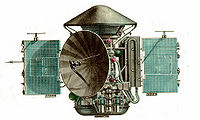
Photo from wikipedia
We present an analysis of the remaining three candidate landing sites for Mars 2020, Columbia Hills (CH), Northeast Syrtis (NES) and Jezero (JE) from the perspective of understanding Mars’ crustal… Click to show full abstract
We present an analysis of the remaining three candidate landing sites for Mars 2020, Columbia Hills (CH), Northeast Syrtis (NES) and Jezero (JE) from the perspective of understanding Mars’ crustal magnetic field. We identify how the different sites can address each of six community-defined paleomagnetic science objectives for Mars return samples. These objectives include understanding the early dynamo field and its variability, identification of magnetic minerals that carry magnetization in the samples, and characterization of any thermal and chemical alteration of samples. Satellite data have provided global and regional constraints on crustal magnetization, indicating strong magnetizations at CH and weak to no magnetization at JE and NES. However, the primary paleomagnetic interest—understanding the early dynamo—requires ground truth from a landing site at which pre-Noachian and Early Noachian deposits are accessible. This requirement is most likely met by the site NES, which contains meggabreccia deposits, and it is therefore the highest priority landing site for magnetic field investigations. Importantly, a sample return mission has never been done, and so any of the three landing sites will provide critical, new data that will contribute to understanding the history of Mars’ magnetic field and crustal mineralogy and, in turn, yield constraints on the planet’s evolution. Plain Language Summary Mars 2020, a mission to Mars, will for the first time collect rock samples for subsequent return to the Earth. Here we evaluate how each of the last three candidate landing sites can shed light on the Martian magnetic field and its history. We evaluate which landing site is best suited to address each of six science objectives regarding the origin, variability, and evolution of the magnetic signatures on Mars. We first summarize what is known about magnetization around the landing sites based on satellite data. Because we are primarily interested in the history of the magnetic field, an ideal site should offer ancient (∼4 billion years old and older) accessible outcrops that might be recorders of Mars’ ancient global magnetic field. We combine current knowledge about the surface age, geology, and magnetic field, and chose Northeast Syrtis as the preferred landing site, followed by Columbia Hills and Jezero. However, any of the three sites will provide us with new data that will contribute to understanding Mars’ magnetic field history and, in turn, its evolution.
Journal Title: Earth and Space Science
Year Published: 2018
Link to full text (if available)
Share on Social Media: Sign Up to like & get
recommendations!